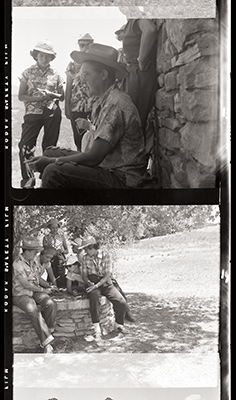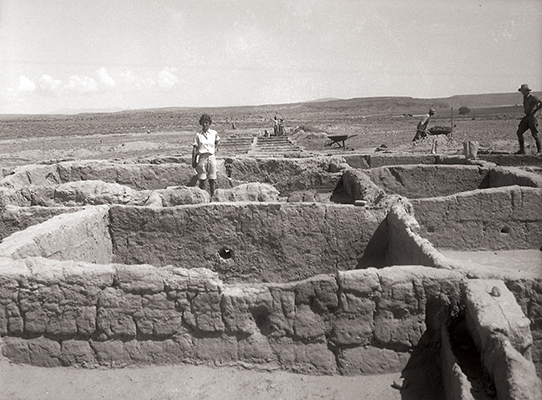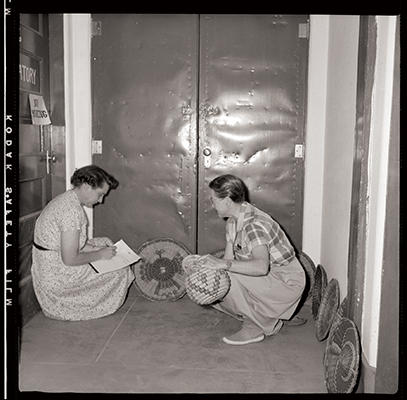They Also Dug
Women archaeologists in the Southwest
 Bertha Dutton, Marjorie, Lambert, Jean Cady, Hulda Hobbs at Alibates site near Amarillo, Texas, ca. 1941. HP.1992.31.21b.
Bertha Dutton, Marjorie, Lambert, Jean Cady, Hulda Hobbs at Alibates site near Amarillo, Texas, ca. 1941. HP.1992.31.21b.
BY CATHERINE S. FOWLER AND NANCY J. PAREZO
If asked, could you name five or more archaeologists famous for digging in the American Southwest in the early to mid-twentieth century? Edgar Lee Hewett, Alfred Kidder, Neal Judd, Earl Morris, Frank Roberts, Emil Haury, and Paul Martin might come to mind. A few archaeology buffs might name Florence Ellis, Marie Wormington, and some Santa Feans might recall Marjorie Lambert or Bertha Dutton, but listing five women—or any women automatically—would be less likely. Many women made important contributions to the Southwest’s archaeology that rarely made news or appeared in books.
Early on, women took advantage of their traditional role as helpmates to embrace the non-traditional tasks of archaeologists. They dug alongside their archaeologist husbands as well as “wrangling camp and grub,” as the saying goes. Those trained or partially trained struggled to find a place—and especially a job—in what was considered at that time a profession for the “hairy-chinned” or the “hairy-chested.” Others able to get advanced degrees and jobs had difficulty obtaining equal pay and advancement—not unlike today. Even fewer, determined to stick with it, made their way as independent scholars, sometimes by offering a special skill that others needed. What they did and how they did it is a fascinating but little-told story.
HUSBAND-AND-WIFE TEAMS
Some of the earliest women who were involved in Southwest excavations were archaeological wives—women like Ann Axtell Morris (1900–1945), who wanted to be an archaeologist from the age of six, “to dig for buried treasure, explore among the Indians, paint pictures, wear a gun, and go to college.” She did all of these things during her short lifetime, but not as fully as she wanted. She partnered with husband Earl Morris in his Southwest excavations at Aztec, Canyon de Chelly, and other Southwest sites, and in Guatemala. She documented pictographs and complex murals through her artistic talent and analyzed intricately woven Ancestral Puebloan sandals. Her books, Digging at Chichen Itza (1931) and Digging in the Southwest (1933), were said to have recruited more students and avocationals into archaeology than all the technical reports penned by her husband.
Avocationals accomplished an immense amount of work. Harriet (Hattie) Cosgrove (1887–1970) and C. Burton Cosgrove excavated Mimbres sites in central New Mexico beginning in the early 1900s. Hattie’s meticulous site-recording techniques and the overall quality of their work led to sponsorship by A.V. Kidder and Harvard’s Peabody Museum. Hattie also constructed site maps, shot photographs, and drew detailed illustrations for their joint report, The Swartz Ruin: A Typical Mimbres Site (1932) published by the Peabody Museum. She was senior author of this report, which is still highly regarded today.
Although married and with a doctorate in education from the University of Pennsylvania, Lucy Langdon Wilson (1864–1937) depended on her husband only to get her foot in the door. She had always been intrigued by archaeology. This interest turned into a passion after she and William toured northern New Mexico with Edgar Lee Hewett in 1914 as members of the Archaeological Institute of America. Described in newspaper accounts as an “indefatigable woman explorer,” she immediately began to look for an archaeological site to excavate, in part to produce an exhibition at the Philadelphia Commercial Museum. On Hewett’s advice, she settled on the area of Otowi near Bandelier. Although she alone would be—and was—in charge (William did not accompany her), permits for her three summers of excavations were issued jointly with his name appearing first. Again following Hewett’s advice, she hired experienced San Ildefonso men as excavators, and archaeologist Wesley Bradfield as field officer. Bradley often cared for Wilson’s small son, a unique gender reversal for the time. The Pueblo workmen dug efficiently and helped Wilson interpret the results. Technical reports from the work were submitted under Lucy and William’s names as permit holders, but the resulting articles, including three in El Palacio, were written by Lucy Wilson alone.
CAREER WOMEN
It took thirty years, but by the late 1920s, women with degrees were being employed as archaeologists in museums, though women who received advanced degrees in archaeology in the 1930s rarely found the job market friendly. As the prominent archaeologist A.V. Kidder wrote to fellow anthropologist Elsie Clews Parsons on April 8, 1929, “This business of women in anthropology is a perplexing one … a young woman, because of the likelihood of her marriage, is an unreliable element to build into the foundation of a staff structure.”
But at least one mentor didn’t think so. Edgar Lee Hewett hired two women as staff members of the Museum of New Mexico: Marjorie Ferguson (later Lambert; 1908–2006) and Bertha P. Dutton (1903–1994), after helping to train them at the University of New Mexico. He hired Ferguson in 1937, after she graduated from UNM with a master’s degree, making her curator of archaeology in 1938. Dutton first worked as Hewett’s administrative assistant at the museum, but then convinced him that the museum needed ethnology exhibits to parallel those on archaeology. Hewett agreed, and promoted her to curator of ethnology in 1939.
Both women spent their careers at the MNM as museum anthropologists, a specialization seen by some academic anthropologists as jobs best suited for women because, according to Yale University professor Clark Wissler, of their “natural housekeeping skills.” But both made significant contributions to Southwest research in archaeology, ethnology, and history, while also educating the public.
Ferguson excavated important sites throughout the state, including in Chaco Canyon, at Kuaua, Paa-ko, Tecolote, San Gabriel del Yunque, Giusewa, and archaic sites in Hidalgo County. She was also in charge of the Palace of the Governors, thus furthering her parallel interests in the Spanish Colonial history. In both capacities, she designed exhibitions, led public tours, and gave presentations in venues around the state. She also fostered good working relationships between avocational and professional archaeologists, especially through the Archaeological Society of New Mexico.
Also an accomplished archaeologist, historian and ethnologist, Dutton excavated at Chaco Canyon (Leyit Kin), in the Galisteo Basin (Pueblo Largo, Las Madres), and in the Salinas area (Abó). Through her joint appointment as a research associate of the School of American Research (now School for Advanced Research), she excavated in Mexico and Guatemala—in a sense having more than one research career. Several times, Dutton developed and redesigned the Hall of Ethnology (at the time in the old armory building on Washington Avenue, behind the Palace of the Governors). As part of outreach to the public, she led twenty-seven archaeological mobile and excavation camps for Senior Girl Scouts (fifteen and a half to eighteen years old) between 1947 and 1957, introducing nearly 300 girls from throughout the nation to the anthropology of the Southwest. This program resulted in several of these young women pursuing advanced degrees in anthropology and related fields. Dutton also earned her PhD at Columbia University during that time, in 1952. She is still well-known for her publication Sun Father’s Way, on the murals at Kuaua, part of Coronado Historic Site.
Lambert and Dutton spent thirty years at the MNM, and expressed their gratitude to Hewett for giving them full-time positions. However, both told us in interviews in the mid-1980s that they never earned as much as their male counterparts, or ever reached true managerial status while there—not uncommon complaints from women, and perhaps a motivation for hiring them. After retiring from the MNM, Dutton was named director the Museum of Navajo Ceremonial Art (now Wheelwright Museum of the American Indian), where she served for ten years.
ITINERANTS
Isabel T. Kelly’s (1906–1983) long and industrious career in archaeology, ethnology, and applied anthropology was once described as “a career trajectory defined by itinerancy.” With advanced degrees in anthropology from the University of California, Berkeley (MA 1927; PhD 1932), she expected to find full-time employment and recognition for her professional abilities. But times were tough during the Great Depression; the few available academic jobs went to men. After surviving on fellowships, grants and temporary positions, she moved to Mexico. She was able to support herself there as an independent scholar, amassing a huge list of successful local and international projects and publications.
Kelly’s work in Southwest archaeology commenced early in her career. She always claimed it was her first love. In 1929, she, Frances Watkins, and Eva Horner were selected to participate in the first archaeological field school offered by the Laboratory of Anthropology under the direction of A.V. Kidder. He agreed to take women on condition that there were enough qualified applicants to form a separate excavation team. Kidder placed the three women at Tecolote, a pueblo near Las Vegas, New Mexico, where they hired and managed a local Hispanic crew. They impressed Kidder with their technique and thoroughness, producing what he somewhat dismissively called “a tidy little excavation,” certainly equal if not superior to the work of the male students engaged elsewhere. From 1936 to 1938, Kelly oversaw excavating the Hodges Site, a large Hohokam village in the heart of Tucson, while affiliated with Gila Pueblo in Globe, Arizona. Although her major archaeological legacy is in west Mexico, she always credited her Southwest experiences as formative.
Anna O. Shepard (1903–1973) experienced another type of itineracy, one dedicated not to excavating sites but providing a specialized service for other archaeologists. After studying and working in archaeology, Shepard acquired laboratory skills to conduct sophisticated analyses to determine the exact composition and production techniques of ceramics. These provided valuable clues to the archaeologists as to where and under what methods vessels were produced. Although her approach was underappreciated at first because of its complexity, it is highly regarded today. Her book Ceramics for the Archaeologist (1957) has been reprinted multiple times. She analyzed pottery from throughout the Southwest, including objects from Pecos Pueblo excavated by Kidder. She held positions at several institutions before developing her laboratory at the University of Colorado, Boulder, where her work was supported by the Carnegie Institution of Washington.
LEGITIMACY
There were some exceptions to the bleak job picture for women in Southwest archaeology in the 1930s. Although Florence Hawley Ellis (1906–1991) lost her teaching job at the University of Arizona in 1933 due to the Great Depression, Hewett was able to hire her in an academic position at the UNM in 1934. (She had finished her PhD at the University of Chicago during the intervening year.) Dean Byron Cummings, another person who encouraged women to study archaeology, mentored Hawley through her MA at the University of Arizona. Hewett had already observed Hawley’s meticulous excavations at Chaco Canyon, when she had served as a summer field assistant, excavating part of Chetro Ketl. Her dissertation fully integrated the ceramic, tree ring, and architectural details she gathered during those excavations, enabling her to be the first scholar to use statistical tests to support her conclusions.
Like Shepard, Ellis also was a pioneer in ceramic analysis. She published Field Manual of Southwestern Pottery Types (1936), focusing on identifications that could be made in the field rather than the laboratory. It too remains highly regarded to this day. Throughout her nearly forty-year career at UNM, Ellis mentored generations of Southwest archaeologists, female and male, in the classroom as well as in her summer field schools at several New Mexico sites. She introduced them to her approach to archaeology—one that integrated history, ethnology, and ethnoarchaeology—thus allowing a richer interpretation of past and present Pueblo life. She developed reports and testified on behalf of contemporary Pueblos in their land and water claims cases, again combining multiple lines of evidence. Her list of publications is impressive, although she spent more time teaching than several of her colleagues. After leaving UNM in 1971, she taught at Ghost Ranch, again offering several archaeological field schools and developing new research interests. The museum on their campus is named in her honor.
EPILOGUE
Now can you name five or more women archaeologists who made important contributions to Southwest archaeology in the early to mid-twentieth century? There is more to learn about the lives and works of these and other women and how they persevered in a field that was once male-dominated, but is no longer; women now slightly outnumber men as members in the international Society for American Archaeology.
However, women still lag in obtaining research funding, and in some places, major managerial positions, equal pay, and recognition for their contributions. But they have moved a long way from where they began in the 1880s; they have advanced from being members of archaeological husband-and-wife teams who were not allowed to obtain excavation permits, to serving as the directors of important, multi-year excavations.
And they are writing their own histories. Young women (and men) who are interested can join avocational organizations in their states, read books and magazines (such as American Archaeology and Archaeology), search the web, speak with archaeologists working in federal and state agencies, parks and monuments, attend public lectures including those offered through their local museums, and take courses in anthropology and archaeology offered in some local schools. The women we profiled here had a passion for archaeology, and they found ways to learn about it and make it work for them.
Catherine S. Fowler is a foundation professor emerita, department of anthropology, University of Nevada, Reno; and research associate, Museum of Indian Arts and Culture/Laboratory of Anthropology. Nancy J. Parezo is a professor emerita of American Indian studies at University of Arizona, Tucson.
Further reading
Leckie, Shirley A. and Nancy J. Parezo, eds. Their Own Frontier: Women Intellectuals Re-Visioning the American West. Lincoln and London: University of Nebraska Press, 2008.
Parezo, Nancy J., ed. Hidden Scholars: Women Anthropologists and the Native American Southwest. Albuquerque: University of New Mexico Press, 1993.





